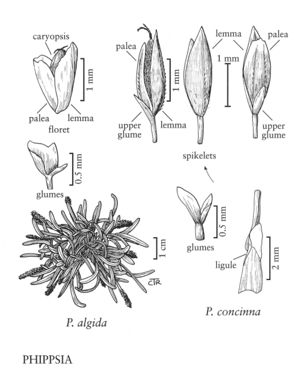Phippsia algida
Culms (2) 3.5-15 cm. Leaves cauline or mostly basal; sheaths glabrous; ligules 0.3-1 (1.6) mm, entire, acute; blades 0.6-2.8 cm long, 1.2-3 mm wide, glabrous. Panicles (0.5) 1-2 (3) cm long, 3-7 mm wide, dense or slightly diffuse; rachises smooth; primary branches (0.9) 3-8 (9.5) mm, smooth, usually appressed, sometimes spreading, particularly at anthesis; secondary branches appressed. Spikelets (1) 1.4-1.8 mm long, (0.5) 0.7-0.9 mm wide, with 1 floret. Glumes caducous, often colorless when present; lower glumes 0.05-0.3 mm, obtuse; upper glumes 0.3-0.6 mm; lemmas 1.3-1.8 mm, broadly ovate, rounded on the back, often yellow-green, never with purple coloration extending to the apices, glabrous or with a few soft hairs on the lower 1/3, sometimes sparsely scabridulous below, apices acute to rounded, entire or lacerate; paleas 1.1-1.3 mm, glabrous; anthers 0.3-0.7 mm. Caryopses 1.2-1.6 mm long, 0.3-0.5 mm wide, ellipsoid, widest at or just above the middle. 2n = 28.
Distribution
Colo., Alaska, Alta., B.C., Greenland, Nfld. and Labr. (Nfld.), N.W.T., Nunavut, Ont., Que., Yukon, Wyo., Mont.
Discussion
Phippsia algida is a circumpolar species that also grows at high elevations in the Rocky Mountains and the Andes. It is one of the first grasses to flower in the high arctic, which may contribute to its success as an early colonizer of disturbed areas. Although highly nitrophilous, it can tolerate a wide range of soils, from highly alkaline to peat and imperfectly drained mud flats. It sometimes hybridizes with Puccinellia vahliana. Plants of P. algida with slightly hairy lemmas have been recognized as P. algida f. vestita Holmb.
The original circumscription of Phippsia algida subsp. algidiformis (Harry Sm.) Á. Löve & D. Love is unclear (Steen et al. 2004). Harry (K.A.H.) Smith subsequently included his specimens in P. concinna, indicating that he no longer recognized the taxon he had described. Some of his specimens, and those of Bay (1992) collected in Greenland, that are deposited at C and O have been reidentified as P. algida or P. concinna (some as depauperate P. concinna) by Reidar Elven (University of Oslo).
Selected References
None.
Lower Taxa
"decumbent" is not a number.
